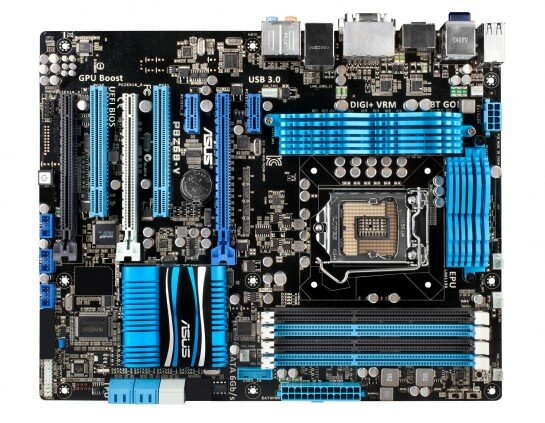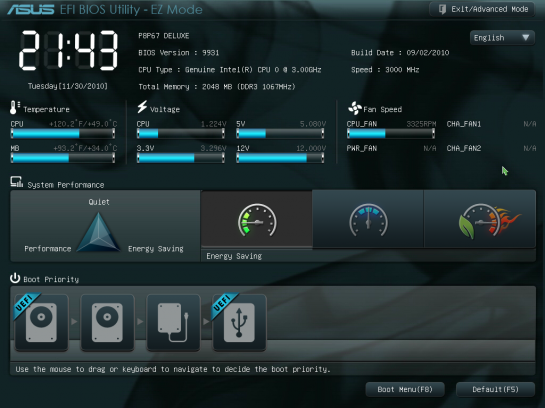P8Z68 Series: The right design for Z68 motherboards
Early in January Intel launched is incredible ‘Sandy Bridge’ series CPUs, officially dubbed its Second Generation Intel Core Processors. The brand name is a bit of a mouthful (and it’s atrocious on SEO if I’m honest), but thankfully its motherboard chipsets were a lot easier to remember, splitting between H67 and P67. Both of these provided separate features; H67 allowed the use of the processor graphics (Intel HD Graphics 2000/3000) and Quick Sync technology, while P67 allowed overclocking of memory and processors with the K-series chips.
For users who wanted to overclock and take advantage Quick Sync, Intel has now launched its Z68 chipset that offers the benefits of both.
Getting the design right is still an important core asset though, because not every Z68 board is made equally.
For example, the P8Z68-V Series not only includes Lucid Virtu graphics switching, but also Intel Smart Storage SSD caching, Dual Intelligent Processors 2 with DIGI+ VRM and true, native UEFI BIOS technology.
Lucid Virtu.
Let’s start from the top; Lucid has worked with Intel to develop a graphics switching technology that automatically flicks between any PCI-Express graphics cards and the processor graphics integrated into the CPU silicon. Simply plug the monitor into the HDMI port on the motherboard rear I/O and install the driver. You don’t need to plug anything into the graphics card as the display output is piped through. This means the low-power processor graphics can take over the 2D work, while leaving the graphics cards to run 3D or Nvidia CUDA, PhysX or AMD Stream applications. It also opens up the use of Intel Quick Sync video transcoding as well, so technically you can run a PC with all three accelerator technologies from Intel, AMD and Nvidia at once! Great for those who require a flexible workstation or are developing applications across all three.
ASUS has gone one step further though; it has additional, physical power hardware to enable the Intel Quick Sync even when the monitor is plugged into the graphics card directly. Now you can run a Quick Sync transcode while you use the graphics card, instead of having to wait to switch back. This means you get the option of gaming while you wait, or running other graphics-accelerated apps like Folding@Home at the same time. That’s true multi-tasking your PC was designed for!
Dual Intelligent Processors 2 with DIGI+ VRM
One of the two fundamental benefits of ASUS P8 series that have been so popular for P67 overclockers has been the Dual Intelligent Processors 2 (DIP2) and DIGI+ VRM hardware. The difference with Z68 vs P67 is that every-single-board now gets the full 16 phase setup: that’s 12 for the CPU and 4 for the processor graphics.
With P8Z68 it seems the DIGI+ VRM continues to be the only hardware capable of delivering exactly what the CPU requests – replying to a digital power request with a digital one back – but the real benefit is in the level of tweaking available for PC enthusiasts and power users; from loadline calibration, to VRM frequencies, to the variety of voltage options – they all do a small part in the bigger picture. This not only benefits CPU multiplier overclocking, but also to get the extra sliver of base-clock overclocking too. CPU base clock can make all the difference to higher memory frequency and bandwidth, and pushing the very boundaries of CPU performance.
Which then brings us to part 2:
UEFI
UEFI – Unified Extensible Firmware Interface - on its own is the correct term, but you’ll also see it presented as UEFI BIOS. Real UEFI actually replaces the BIOS, but it not only performs the same function, it extends it (hence, extensible firmware). UEFI is not only visually better thanks to its support for higher resolution displays, more colors and mouse control with drag and drop icons, but also from the bits underneath that give it native support for 3TB+ hard drives.
ASUS’ design follows Intel’s own specification of what EFI is absolutely, this way it betters hardware compatibility and is honest in its approach. It’s not Windows software or yet another facelift to the sagging 20+ year old BIOS - it’s real UEFI as Intel intended and so many users to date have preferred.
You see, for years many users have been put-off by complicated looking BIOS’, and because of that ASUS has taken the opportunity to split its UEFI into two modes: EZ mode and Advanced mode. EZ mode has all the basic features and is designed with a GUI-heavy interface around OS-like mouse control to select the options. It’s straight forward.
For pro-users who still want that bare metal control though, advanced mode houses all the core tweaks and customized tuning and overclocking options. ASUS tweaks the presentation of these modes in its Republic of Gamers range, which are not only red and black to match the board colors, it automatically drop into the Advanced Mode first to better reflect its knowledgeable users.
There’s more to Z68 motherboards than just a stats table of new features, so we encourage you to take the time, research tech reviews and understand that you’re better off getting the right design with real innovations.




Matt Black
Raised by wolves in the wilderness, he one day met a bear who taught him there was more to life than just the jungle. From here, he fought his way to the city, foraging for tech on his travels. Today, still searching for the ultimate technology, he survives as a soldier of fortune. If you have spare kit, if no one else can help, and if you know his number, maybe you can hire... Matt Black.